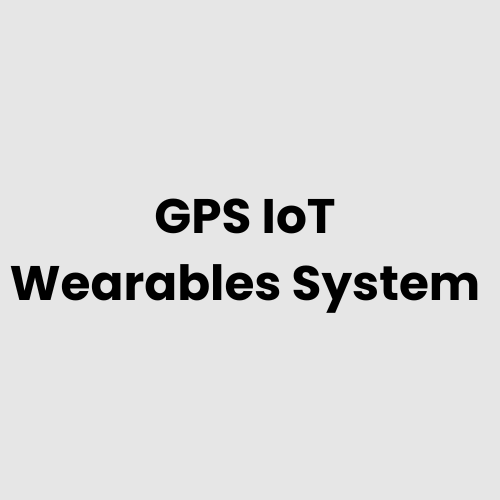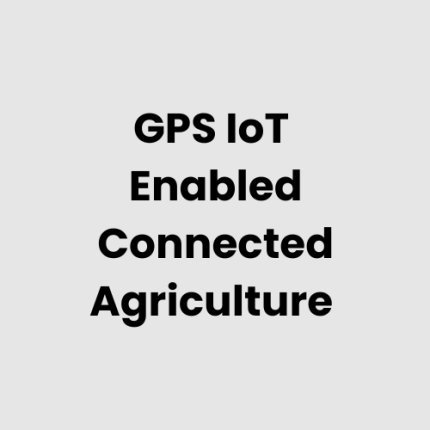Description
Technical Architecture of GPS IoT Enabled Wearables IoT System
The GPS IoT Enabled Wearables IoT System integrates real-time GPS tracking with wearable devices to monitor vital health parameters, location, and activity. The system includes a central processing unit (CPU) that gathers data from embedded GPS sensors, accelerometers, heart rate monitors, and communication modules (e.g., Bluetooth, LTE). The data is transmitted to a cloud-based platform or local servers, where it is analysed and stored for real-time monitoring, alerts, and reporting. The system ensures seamless connectivity between wearables, cloud servers, and mobile apps, providing actionable insights for healthcare, fitness, and enterprise applications.
Hardware of GPS IoT Enabled Wearables IoT System
- Wearable Devices – Smartwatches, fitness trackers, health monitors equipped with GPS, accelerometers, heart rate sensors, and communication modules.
- GPS Sensors – Embedded GPS sensors for precise location tracking in real-time.
- Wireless Communication Modules – Bluetooth Low Energy (BLE), Wi-Fi, and LTE for transmitting data between devices and cloud systems.
- Battery Modules – Rechargeable battery systems optimized for extended use of wearables.
- Processing Units – Microcontrollers and microprocessors that process sensor data locally on the device before transmission.
- Cloud Gateway – A local device or server that aggregates data from wearables and communicates with the cloud.
- Cloud Servers – A secure cloud platform for data storage, analytics, and processing.
- Mobile Applications – Companion apps for smartphones and tablets for remote monitoring and user engagement.
Physical Placement Considerations of the Hardware of GPS IoT Enabled Wearables IoT System
- Wearable Devices: The devices should be worn on the body, typically on the wrist, chest, or waist, depending on the application (e.g., fitness, healthcare, or personal safety).
- GPS Sensors: Positioned within the wearable device, these sensors must have an unobstructed view of the sky for optimal satellite signal reception.
- Communication Modules: The communication modules should be designed to operate seamlessly in environments with varied wireless coverage. For urban environments, LTE and Wi-Fi should be prioritized, while rural or remote locations may require satellite-based communication.
- Battery: Battery life considerations are essential, and devices should be designed with efficient power management for long-term use without frequent charging.
- Processing Units: These should be compact and power-efficient, integrated into the wearable without adding significant weight or bulk.
Hardware Architecture of GPS IoT Enabled Wearables IoT System
The system’s hardware architecture consists of multiple components working in synergy:
- Wearable Devices: Contain GPS sensors, accelerometers, and heart rate sensors, transmitting collected data via Bluetooth or cellular networks.
- Communication Interface: Devices use wireless protocols like Bluetooth and LTE for data transmission to mobile apps, cloud platforms, or local servers.
- Edge Computing: Wearables perform initial data processing (e.g., filtering or aggregating data) to minimize the load on cloud servers, ensuring efficient data transfer and analysis.
- Cloud Platform: Data from wearables is sent to cloud servers for deeper analysis, historical data storage, and long-term trend monitoring.
- Mobile and Web Applications: User interfaces display real-time data, insights, and notifications, offering remote monitoring and analytics.
Deployment Considerations of GPS IoT Enabled Wearables IoT System
- Scalability: The system should be scalable to accommodate different numbers of wearables, ranging from personal devices to enterprise-level deployments with thousands of units.
- Connectivity: Depending on the geographic location, wearables may rely on various connectivity options, including Wi-Fi, LTE, Bluetooth, or satellite communication for remote areas.
- Security: Ensuring the security of personal health data is paramount. The system must comply with industry standards for data protection, including encryption of data in transit and at rest.
- Battery Life and Power Management: Efficient battery management is essential for continuous operation, with regular software updates optimizing power consumption.
- Compliance: Adherence to relevant healthcare and safety standards, ensuring that the system meets necessary regulatory requirements in specific regions.
List of Relevant Industry Standards and Regulations
- ISO/IEC 27001 (Information Security Management)
- ISO 13485 (Medical Devices)
- Health Insurance Portability and Accountability Act (HIPAA)
- General Data Protection Regulation (GDPR)
- Federal Communications Commission (FCC) Regulations
- ISO 9001 (Quality Management Systems)
- ISO/IEC 11801 (Generic Cabling for Customer Premises)
- Bluetooth SIG Standards (for communication protocols)
- RoHS Compliance (Restriction of Hazardous Substances)
Local Server Version – Running with a Local Server
In the local server version of the GPS IoT Enabled Wearables IoT System, the data collected by wearables is transmitted to a local server instead of the cloud. This version is useful for environments where local data storage and processing are preferred due to security or compliance concerns. The local server handles the storage, real-time processing, and management of the data generated by wearables. This setup offers reduced latency, increased control over data privacy, and faster access to real-time insights, especially for critical applications in healthcare or personal safety.
Cloud Integration and Data Management
Cloud integration allows wearables to transmit real-time data to a centralized cloud platform for analysis, storage, and sharing. The cloud platform processes and stores the data securely, providing advanced analytics and insights. This integration supports large-scale deployments, allowing easy access to data from multiple devices, offering a global view of user activities, health metrics, or location tracking. The cloud infrastructure also enables remote software updates, ensuring that wearables are always running the latest features and optimizations. GAO Tek’s solution can seamlessly integrate with any cloud service provider, ensuring that data management is scalable, secure, and compliant with relevant regulations. Data can be visualized on web and mobile applications, providing users and administrators with timely, actionable insights.
GAO Case Studies of GPS IoT Enabled Wearables IoT System
United States
- New York City, NY
A leading healthcare provider utilized GPS-enabled wearable devices to monitor patients’ vital signs and location in real-time. The system enabled healthcare professionals to remotely track the health status of elderly patients, ensuring timely intervention in case of emergencies and improving patient care outcomes.
- San Francisco, CA
A fitness company integrated GPS IoT-enabled wearables into its fitness tracking system, offering users real-time workout analytics and location tracking. This solution not only helped users track their activities but also improved their training efficiency through location-specific recommendations and performance insights.
- Los Angeles, CA
A global logistics company implemented wearable devices to monitor the health and well-being of delivery personnel. These wearables provided real-time feedback on employees’ physical condition, improving workplace safety and reducing health-related incidents by alerting managers to potential issues.
- Chicago, IL
In Chicago, a smart city initiative incorporated wearable devices with GPS tracking for public safety. The system enabled emergency responders to monitor the location of individuals in distress, ensuring faster response times in critical situations and improving the overall efficiency of first responders.
- Miami, FL
A technology start up in Miami launched a wearable IoT system for tourists visiting the city. The system offered GPS-based navigation, activity suggestions, and safety features, improving the tourist experience and helping city authorities manage foot traffic in high-traffic areas.
- Seattle, WA
In Seattle, a university collaborated with a healthcare organization to develop a wearables-based system for mental health monitoring. GPS-enabled wearables tracked students’ movements and provided early alerts to counsellors when potential mental health risks were identified based on location patterns and activity levels.
- Austin, TX
An oil and gas company in Austin integrated wearable devices for workforce safety in hazardous environments. The wearables provided continuous GPS tracking and health monitoring, enabling the company to ensure the safety of its employees by triggering alerts for unusual behaviour, health concerns, or dangerous locations.
- Boston, MA
A major research university in Boston used GPS-enabled wearables to enhance campus safety. The system allowed students to wear devices that could send real-time alerts to campus security personnel when they entered unsafe zones, improving the overall security of the campus community.
- Dallas, TX
A transportation company in Dallas deployed wearable devices for its truck drivers. These GPS-enabled wearables monitored the drivers’ health and fatigue levels in real-time, reducing the risk of accidents due to driver fatigue and improving overall fleet safety.
- Washington, D.C.
A federal government agency in Washington, D.C. utilized GPS wearables for field agents working in remote locations. These wearables enabled supervisors to track the location of agents and ensure safety in real-time while gathering crucial data from the field for government projects.
- Houston, TX
A healthcare provider in Houston adopted GPS IoT-enabled wearables for elderly care. The system allowed healthcare workers to monitor seniors’ physical activity levels, heart rates, and location, ensuring early detection of medical issues and better management of chronic conditions.
- Denver, CO
In Denver, a sports team implemented GPS-enabled wearables for player performance tracking. The system tracked movement, heart rate, and other vital statistics, providing coaches with valuable insights to optimize player performance and reduce the risk of injury during training and matches.
- Phoenix, AZ
A local community centre in Phoenix integrated wearable devices into its senior activity program. The wearables tracked the participants’ physical activities and location, ensuring the safety of seniors during outdoor activities and providing immediate alerts in case of emergencies.
- Orlando, FL
A theme park in Orlando used GPS-enabled wearables for its staff, ensuring the safety of its employees working in the park. The system allowed for real-time tracking of staff locations during high-traffic periods, optimizing safety and performance by enabling quick responses to emergencies.
- Salt Lake City, UT
A winter sports resort in Salt Lake City utilized GPS wearables for guest safety. The system provided real-time location tracking of skiers and snowboarders, ensuring that rescue teams could reach those in distress more efficiently and manage guest safety in the event of an emergency.
Canada
- Toronto, ON
A healthcare organization in Toronto integrated GPS-enabled wearables for remote monitoring of patients with chronic conditions. The wearables tracked the patient’s physical activity, heart rate, and location, enabling healthcare providers to detect early signs of health issues and intervene promptly.
- Vancouver, BC
A technology company in Vancouver implemented wearable IoT devices in a smart city project. The system used GPS-enabled wearables to track the location and well-being of construction workers on-site, improving safety by providing real-time updates on workers’ locations and sending alerts for emergency situations.
Navigation Menu for GPS IoT
- GPS IoT Trackers/Devices
- GPS IoT Tracking Accessories
- GPS IoT Tracking Resources
- GPS IoT – Cloud, Server, PC & Mobile Systems
Navigation Menu for IoT
- LORAWAN
- Wi-Fi HaLow
- Z-WAVE
- BLE & RFID
- NB-IOT
- CELLULAR IOT
- GPS IOT
- IOT SENSORS
- EDGE COMPUTING
- IOT SYSTEMS
Our products are in stock and can be shipped anywhere in the continental U.S. or Canada from our local warehouse. For any further information, please fill out this form or email us.
We are actively looking for partners who are like us located in the U.S. and Canada. For more information on partnering with GAO, please visit Partner with GAO Tek Inc. It lists various ways to partner with GAO, such as OEM Partnerships, Technology Integration, Distribution and Reselling Opportunities, Presenting at the Leading Event Tek Summit, Joint R&D Projects, Training and Consulting Services, Industry-Specific Collaborations, Research and Academic Partnerships.



